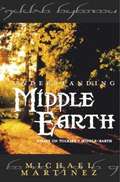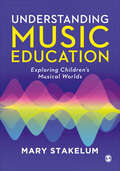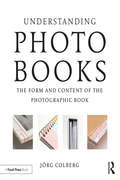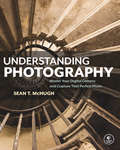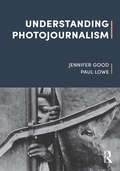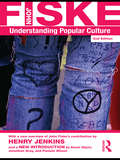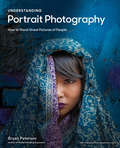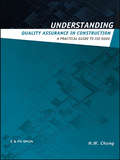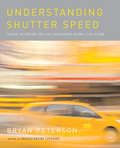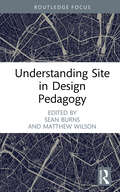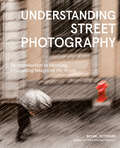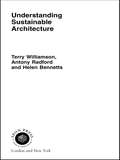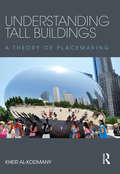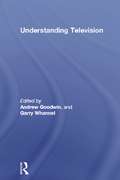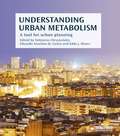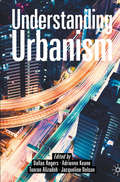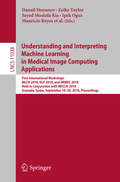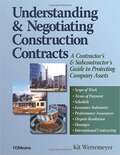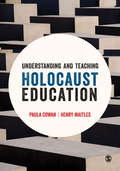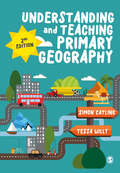- Table View
- List View
Understanding Middle Earth: Essays on Tolkien's Middle-Earth
by Michael MartinezMichael Martinez calls himself a populist commentator. He has long been an advocate for fans of science fiction honing his encyclopedic knowledge of all of the works of J. R. R. Tolkien with Tolkien special interest groups on the internet, arranging Tolkien programming at fan run science fiction and fantasy conventions and making live, sophisticated presentations to audiences world wide. His coverage of Tolkien Topics in this collection of 36 essays is so thorough that you will feel as if Martinez has left no stone on Middle-earth unturned. He explains how the first elves lost their innocence taking their first step on a long road, filled with loss and grief, toward sorrow. He describes what they lost on their 500 year journey across a frozen wasteland and how Melkor's lies transformed artists who celebrated beauty to avaricious, vengeful, murdering, hoarders. He outlines the long lives of some of our favorite Elves including Gil-galad, Glorfindel and Legolas. He explains how the roles of elves changed through the long ages. For example, Elrond evolved from a warrior to an innkeeper. Exuberant, benevolent yet powerful Tom Bombadil is beloved by most Tolkien readers. Martinez illustrates Bombadil's importance to The Lord of the Rings and makes a strong case that it is a mistake to underrate him or pass him over as nonessential to the plot. We learn that only a few elves were vegetarians and that limbas is much like our cornbread though the corn used by the elves was a special, magical variety. Most of Tolkien's evil characters paid dearly for their deviation from goodness. In one essay Martinez explains why unlike other villains, Frodo is forgiven for crumbling and claiming the ring as his own instead of casting it in to the fire. This long book answers many of your questions about Tolkien's writing and stimulates further thought and debate on Tolkien's complex fantasy. Whether you read it all or skip to the essays that interest you, time spent reading this fascinating, well grounded book will enrich your Tolkien experience. A list of accented words with a key identifying the specific accents is provided on pages III and IV.
Understanding Movies (4th Edition)
by Louis GiannettiThis book helps readers understand how the many languages of film work together to create meaning. Louis Giannetti organizes Understanding Movies around the key elements of filmmaking, including cinematography, movement, editing, sound, acting, drama, casting, story, screenwriting, ideology, and theory. The book is meant for everyone who wants to understand the artistry and meaning of the movies.
Understanding Music Education: Exploring Children′s Musical Worlds
by Mary StakelumThis book is a contemporary analysis of children’s music education, combining theoretical insight with practical application. It examines how children engage with, and think about, music and how an understanding of this can empower rich approaches to teaching and learning. Key topics include: an overview of music education as a field of study, musical imagination in thought and practice, musical worlds created with, and for, children and a range of perspectives on musicality and musical knowledge in childhood. This is essential reading for anyone involved in music education with children, including music leaders working in community settings, and for primary school teachers, and those training to teach, seeking to deepen their own professional understanding. Mary Stakelum is Area Leader, Music Education at the Royal College of Music.
Understanding Music Education: Exploring Children′s Musical Worlds
by Mary StakelumThis book is a contemporary analysis of children’s music education, combining theoretical insight with practical application. It examines how children engage with, and think about, music and how an understanding of this can empower rich approaches to teaching and learning. Key topics include: an overview of music education as a field of study, musical imagination in thought and practice, musical worlds created with, and for, children and a range of perspectives on musicality and musical knowledge in childhood. This is essential reading for anyone involved in music education with children, including music leaders working in community settings, and for primary school teachers, and those training to teach, seeking to deepen their own professional understanding. Mary Stakelum is Area Leader, Music Education at the Royal College of Music.
Understanding Photobooks: The Form and Content of the Photographic Book
by Jorg ColbergUnderstanding Photobooks is a user-friendly guide to engaging with the photographic book— or, as it is widely known, the photobook. Despite its importance as a central medium in which many photographers showcase their work today, there is surprisingly little information on the mechanics of the photobook: what exactly it does and how it does it. Written for makers and artists, this book will help you develop a better understanding of the images, concept, sequence, design, and production of the photobook. With an awareness of the connections between these elements, you’ll be able to evaluate photobooks more clearly and easily, ultimately allowing for a deeper and more rewarding experience of the work.
Understanding Photography: Master Your Digital Camera and Capture That Perfect Photo
by Sean T. McHughComprehensive, heavily illustrated volume introduces the concepts and techniques of digital image capture, including exposure, composition, histograms, depth of field, advanced lighting, lens filters, shutter speed, and autofocus.Learn the core concepts and techniques you need to know to take better photos, from choosing the best lens for your stylistic goals to selecting the right camera settings for different lighting conditions.With clear explanations and highly visual examples, Sean T. McHugh takes you from basic concepts like exposure and depth of field to more advanced topics, such as how camera lenses and sensors capture light to produce images. You'll learn not only which camera settings to use in different situations but also the reasons why.Learn how to:- Choose lenses that give greater control over perspective- Minimize image noise by understanding how digital sensors work- Get the exposure you want even in fog, mist, or haze- Improve hand-held shots by mastering shutter speed and autofocus- Use tripods, lens filters, and flash to enhance image captureWhether you want to understand digital photography at a deeper level or simply want to take better photos, Understanding Photography will help you get the most out of your camera.
Understanding Photojournalism
by Paul Lowe Jennifer GoodUnderstanding Photojournalism explores the interface between theory and practice at the heart of photojournalism, mapping out the critical questions that photojournalists and picture editors consider in their daily practice and placing these in context. Outlining the history and theory of photojournalism, this textbook explains its historical and contemporary development; who creates, selects and circulates images; and the ethics, aesthetics and politics of the practice. Carefully chosen, international case studies represent a cross section of key photographers, practices and periods within photojournalism, enabling students to understand the central questions and critical concepts. Illustrated with a range of photographs and case material, including interviews with contemporary photojournalists, this book is essential reading for students taking university and college courses on photography within a wide range of disciplines and includes an annotated guide to further reading and a glossary of terms to further expand your studies.
Understanding Popular Culture
by John FiskeThis revised edition of a now classic text includes a new introduction by Henry Jenkins, explaining ‘Why Fiske Still Matters’ for today’s students, followed by a discussion between former Fiske students Kevin Glynn, Jonathan Gray, and Pamela Wilson on the theme of ‘Reading Fiske and Understanding the Popular’. Both underline the continuing relevance of this foundational text in the study of popular culture. What is popular culture? How does it differ from mass culture? And what do popular "texts" reveal about class, race, and gender dynamics in a society? John Fiske answers these and a host of other questions in Understanding Popular Culture. When it was first written, Understanding Popular Culture took a groundbreaking approach to studying such cultural artifacts as jeans, shopping malls, tabloid newspapers, and TV game shows, which remains relevant today. Fiske differentiates between mass culture – the cultural "products" put out by an industrialized, capitalist society – and popular culture – the ways in which people use, abuse, and subvert these products to create their own meanings and messages. Rather than focusing on mass culture’s attempts to dominate and homogenize, he prefers to look at (and revel in) popular culture’s evasions and manipulations of these attempts. Designed as a companion to Reading the Popular, Understanding Popular Culture presents a radically different theory of what it means for culture to be popular: that it is, literally, of the people. It is not imposed on them, it is created by them, and its pleasures and meanings reflect popular tastes and concerns – and a rejection of those fostered by mass culture. With wit, clarity, and insight, Professor Fiske debunks the myth of the mindless mass audience, and demonstrates that, in myriad ways, popular culture thrives because that audience is more aware than anyone guesses.
Understanding Portrait Photography: How to Shoot Great Pictures of People Anywhere
by Bryan PetersonCapture the perfect portrait--even if it's with a selfie--in this updated edition of a trusted classic, now with all-new photography.Great portraits go beyond a mere record of a face. They reveal one of the millions of intimate human moments that make up a life. In Understanding Portrait Photography, renowned photographer Bryan Peterson shows how to spot those "aha!" moments and capture them forever. Rather than relying on pure luck and chance to catch those moments, Peterson's approach explains what makes a photo memorable, how to spot the universal themes that everyone can identify with, and how to use lighting, setting, and exposure to reveal the wonder and joy of everyday moments. This updated edition includes new sections on capturing the perfect selfie, how to photograph in foreign territory while being sensitive to cultures and customs, how to master portraiture on an iPhone, and the role of Photoshop in portraiture. Now with brand-new photography, Understanding Portrait Photography makes it easy to create indelible memories with light and shadow.
Understanding Quality Assurance in Construction: A Practical Guide to ISO 9000 for Contractors (Understanding Construction)
by H.W. ChungThe ISO 9000 family of quality standards has been adopted world-wide as a framework for building better relationships between suppliers and customers. Originally a manufacturing-industry concern, quality is now acknowledged to be a key issue for the construction sector whose clients increasingly demand quality certification. This book explains the concepts and practice of quality assurance and management in construction. Clearly written and well illustrated, with plenty of sample quality system documents and other pro-forma, this book will make the daunting task of developing, implementing and managing a quality system a great deal easier for contractors.This is practical guide for building and construction contractors and sub-contractors, project managers and other construction professionals. Also for undergraduate and postgraduate students of building, construction management and project management.
Understanding Shutter Speed
by Bryan PetersonThe first book in the Understanding Photography series,Understanding Exposure, was a runaway best-seller, with more than 250,000 copies sold. Now author Bryan Peterson brings his signature style to another important photography topic: shutter speed. With clear, jargon-free explanations of terms and techniques, plus compelling “before-and-after” photos that pair a mediocre image (created using the wrong shutter speed) with a great image (created using the right shutter speed), this is the definitive practical guide to mastering an often-confusing subject. Topics include freezing and implying motion, panning, zooming, exposure, Bogen Super Clamps, and rendering motion effects with Photoshop, all with helpful guidance for both digital and film formats. Great for beginners and serious amateurs,Understanding Shutter Speedis the definitive handy guide to mastering shutter speed for superb results.
Understanding Site in Design Pedagogy (Routledge Focus on Design Pedagogy)
by Sean Burns Matthew WilsonThis book examines diverse ways of questioning, critiquing, and communicating site in the creative process of architecture, interior design, urban planning, and historical and cultural studies. The authors use the term site to connote a series of complex, established, or pre-existing conditions – a setting, an atmosphere, an area – to read, to interpret, to relate to, and to engage with, to redefine, or to create in relation to a design prompt. By acknowledging, accommodating, and empowering the physical, intellectual, and cultural characteristics of a site, students question its history, boundaries, posture, and situational aspects. Such inquiries promote a deeper appreciation of a site and thus help students to acknowledge its capacity to influence design throughout the iterative creative process. Understanding Site in Design Pedagogy adds to the body of literature on design studio pedagogy by presenting a collection of essays that challenge normative assumptions about what defines a site and its distinctive qualities. It poses a series of pedagogical questions for how sites might be diversely interpreted and introduced to design students. This study offers chapters that speak to site, memory, and lived experience; multi-scalar thinking about site; connecting to site through sensory phenomenon in interior design; alternate ways of engaging site for learning sustainable principles; and introducing unorthodox forms of site as the impetus to creative endeavours. It offers innovative approaches to scholarship of teaching and learning with respect to diverse readings of site within design education.
Understanding Street Photography: An Introduction to Shooting Compelling Images on the Street
by Bryan PetersonDiscover the secrets to mastering street photography—from city streets to country roads and the alleyways in between—from an acclaimed international photographer, teacher, and bestselling author.Street photography offers treasured moments at almost every turn, if you know where to look. In Understanding Street Photography, readers will learn the techniques for capturing brilliant scenes, including images taken around the globe, from the vibrant streets of Varanasi, India, to the crowded walkways of the Charles Bridge in Prague, and so many other corners of the world. In this master class, street photography is defined as images that convey evidence of human interaction, whether that&’s a striking cityscape, an image of rush-hour foot traffic, the remains of a half-eaten sandwich, or a pedestrian portrait. Along the way, Bryan Peterson shares 120 &“mini diaries&”: the story behind each image; the thought process; the arrangement of the composition; the psychology of the colors; and the lens, aperture, shutter speed, and ISO for readers to replicate his work. Professional and aspiring photographers alike will learn how to produce posed and candid compositions, capture light and movement, work with shadows, weather, and architecture, and hone your craft. Through lessons, exercises, and anecdotes, Peterson shares his best tips for capturing the unpredictable world of urban life in motion.
Understanding Sustainable Architecture
by Antony Radford Helen Bennetts Terry WilliamsonUnderstanding Sustainable Architecture is a review of the assumptions, beliefs, goals and bodies of knowledge that underlie the endeavour to design (more) sustainable buildings and other built developments. Much of the available advice and rhetoric about sustainable architecture begins from positions where important ethical, cultural and conceptual issues are simply assumed. If sustainable architecture is to be a truly meaningful pursuit then it must be grounded in a coherent theoretical framework. This book sets out to provide that framework. Through a series of self-reflective questions for designers, the authors argue the ultimate importance of reasoned argument in ecological, social and built contexts, including clarity in the problem framing and linking this framing to demonstrably effective actions. Sustainable architecture, then, is seen as a revised conceptualisation of architecture in response to a myriad of contemporary concerns about the effects of human activity. The aim of this book is to be transformative by promoting understanding and discussion of commonly ignored assumptions behind the search for a more environmentally sustainable approach to development. It is argued that design decisions must be based on both an ethical position and a coherent understanding of the objectives and systems involved. The actions of individual designers and appropriate broader policy settings both follow from this understanding.
Understanding Tall Buildings: A Theory of Placemaking
by Kheir Al-KodmanyIn recent years, the rapid pace of tall building construction has fostered a certain kind of placelessness, with many new tall buildings being built out of scale, context and place. By analyzing hundreds of tall buildings and by providing hundreds of visuals that inspire, stimulate and engage, Understanding Tall Buildings contends that well-designed tall buildings can rejuvenate cities, ignite economic activity, support social life and boost city pride. Although this book does not claim to possess all the solutions, it does propose specific tall building design guidelines that may help to promote placemaking. Through this work, it is the author’s hope that ill-conceived developments will become less common in the future and that good placemaking will become the norm, not the exception. This book is a must-read for students and practitioners working to create better tall buildings and better urban environments.
Understanding Television (Studies in Culture and Communication)
by Andrew Goodwin Garry WhannelUnderstanding Television offers an introduction to some of the issues of television broadcasting and its main genres. It examines a number of programme categories, such as news, drama-documentary, sit-com, soap opera, sport and quizzes, and discusses aspects of the history of the organisation of television, its audiences and its future; it also looks at some key conceptual debates about hegemony in contemporary television
Understanding Urban Metabolism: A Tool for Urban Planning
by Nektarios Chrysoulakis Eduardo Anselmo Castro Eddy J. MoorsUnderstanding Urban Metabolism addresses the gap between the bio-physical sciences and urban planning and illustrates the advantages of accounting for urban metabolism issues in urban design decisions. Urban metabolism considers a city as a system, and distinguishes between energy and material flows as its components. Based on research from the BRIDGE project, this book deals with how the urban surface exchanges and transforms energy, water, carbon and pollutants in cities. This book also introduces a new method for evaluating how planning alternatives can modify the physical flows of urban metabolism components and how environmental and socioeconomic components interact. The inclusion of sustainability principles into urban planning provides an opportunity to place the new knowledge provided by bio-physical sciences at the centre of the planning process, but there is a strong need to bridge knowledge and practice, as well as for a better dissemination of research results and exchange of best practice. This book meets that need and provides the reader with the necessary tools to integrate an understanding of urban metabolism into urban planning practice.
Understanding Urbanism
by Dallas Rogers Tooran Alizadeh Adrienne Keane Jacqueline NelsonUnderstanding Urbanism presents built environment students with the latest approaches to studying urbanism. The book is written in an accessible and easy-to-understand format by leading urban academics and practitioners with decades of teaching and practical experience. As students move through the chapters, they will develop a critical understanding of the different ways architects, urban and social planners, urban designers, heritage professionals, engineers and other built environment professionals design our cities. Importantly, the book shows how and why the built environment professional of the future will need to work within the Indigenous context of cities in countries like Australia, New Zealand, the United States and Canada.
Understanding and Interpreting Machine Learning in Medical Image Computing Applications: First International Workshops, Mlcn 2018, Dlf 2018, And Imimic 2018, Held In Conjunction With Miccai 2018, Granada, Spain, September 16-20, 2018, Proceedings (Lecture Notes in Computer Science #11038)
by Sergio Pereira Mauricio Reyes M. Jorge Cardoso Ipek Oguz Lena Maier-Hein Danail Stoyanov Zeike Taylor Anne Martel Seyed Mostafa Kia Andre F. Marquand Edouard Duchesnay Tommy Löfstedt Bennett Landman Carlos A. Silva Raphael MeierThis book constitutes the refereed joint proceedings of the First International Workshop on Machine Learning in Clinical Neuroimaging, MLCN 2018, the First International Workshop on Deep Learning Fails, DLF 2018, and the First International Workshop on Interpretability of Machine Intelligence in Medical Image Computing, iMIMIC 2018, held in conjunction with the 21st International Conference on Medical Imaging and Computer-Assisted Intervention, MICCAI 2018, in Granada, Spain, in September 2018. The 4 full MLCN papers, the 6 full DLF papers, and the 6 full iMIMIC papers included in this volume were carefully reviewed and selected. The MLCN contributions develop state-of-the-art machine learning methods such as spatio-temporal Gaussian process analysis, stochastic variational inference, and deep learning for applications in Alzheimer's disease diagnosis and multi-site neuroimaging data analysis; the DLF papers evaluate the strengths and weaknesses of DL and identify the main challenges in the current state of the art and future directions; the iMIMIC papers cover a large range of topics in the field of interpretability of machine learning in the context of medical image analysis.
Understanding and Negotiating Construction Contracts: A Contractor's and Subcontractor's Guide to Protecting Company Assets
by Kit WerremeyerConstruction is a complex business. Each project has its own unique physical and commercial considerations. Since there's no such thing as a "standard" or "typical" construction project, construction contracts should also not be considered standard. The contractor must carefully manage both in order to have a successful outcome and protect the company's interests and assets. This book will help you manage all these elements of the contract:- Scope of work and schedule - Terms of payment and cash flow - Assurances of performance - Insurance, bonding, indemnity, and warranties - Changes to the contract - Disputes and their resolution - Damages - Termination and suspension - Force majeure - International contracting
Understanding and Teaching Holocaust Education
by Paula Cowan Professor Henry MaitlesThe Holocaust is a controversial and difficult teaching topic that needs to be approached sensitively and with an awareness of the complex and emotive issues involved. This book offers pragmatic pedagogical and classroom-based guidance for teachers and trainee teachers on how to intelligently teach holocaust education in a meaningful and age-appropriate way. Key coverage includes: Practical approaches and useful resources for teaching in schools Holocaust education and citizenship Holocaust remembrance as an educational opportunity How to explore the topic of anti-semitism in the classroom Exploring international perspectives on holocaust education
Understanding and Teaching Holocaust Education
by Paula Cowan Professor Henry MaitlesThe Holocaust is a controversial and difficult teaching topic that needs to be approached sensitively and with an awareness of the complex and emotive issues involved. This book offers pragmatic pedagogical and classroom-based guidance for teachers and trainee teachers on how to intelligently teach holocaust education in a meaningful and age-appropriate way. Key coverage includes: Practical approaches and useful resources for teaching in schools Holocaust education and citizenship Holocaust remembrance as an educational opportunity How to explore the topic of anti-semitism in the classroom Exploring international perspectives on holocaust education
Understanding and Teaching Holocaust Education
by Paula Cowan Professor Henry MaitlesThe Holocaust is a controversial and difficult teaching topic that needs to be approached sensitively and with an awareness of the complex and emotive issues involved. This book offers pragmatic pedagogical and classroom-based guidance for teachers and trainee teachers on how to intelligently teach holocaust education in a meaningful and age-appropriate way. Key coverage includes: Practical approaches and useful resources for teaching in schools Holocaust education and citizenship Holocaust remembrance as an educational opportunity How to explore the topic of anti-semitism in the classroom Exploring international perspectives on holocaust education
Understanding and Teaching Holocaust Education
by Paula Cowan Professor Henry MaitlesThe Holocaust is a controversial and difficult teaching topic that needs to be approached sensitively and with an awareness of the complex and emotive issues involved. This book offers pragmatic pedagogical and classroom-based guidance for teachers and trainee teachers on how to intelligently teach holocaust education in a meaningful and age-appropriate way. Key coverage includes: Practical approaches and useful resources for teaching in schools Holocaust education and citizenship Holocaust remembrance as an educational opportunity How to explore the topic of anti-semitism in the classroom Exploring international perspectives on holocaust education
Understanding and Teaching Primary Geography (Achieving QTS Series)
by Tessa Willy Professor Simon J CatlingThis book outlines how good teaching of primary geography can extend children's world awareness and help them make connections between their environmental and geographical experiences. Chapters offer guidance on important learning and teaching issues as well as the use and creation of resources from the school environment to the global context. It covers all the key topics in primary geography including: understanding places physical and human geography environmental sustainability learning outside the classroom global issues citizenship and social justice. Summaries, classroom examples and practical and reflective tasks are included throughout to foster understanding and support the effective teaching of primary geography.
